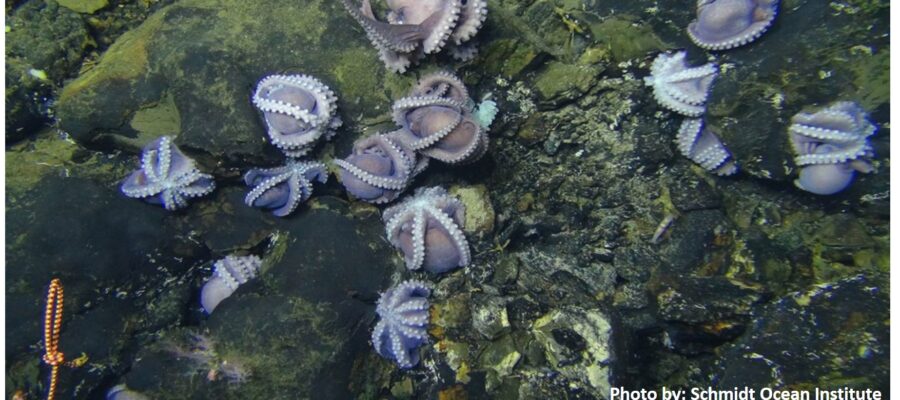The discovery is significant because it is only the third known octopus nursery in the world. The other two nurseries are located in the Davidson Seamount off the coast of Monterey, California, and on a basalt outcrop in the North Pacific Ocean known as Baby Bare.
The scientists believe that the octopuses in the nursery are attracted to the rocky outcrop because it provides a safe place to brood their eggs. The outcrop is also home to a variety of marine life, which provides the octopuses with food.
The scientists plan to return to the nursery in December to collect octopus eggs and to learn more about the octopuses that live there. They hope that their research will help to shed light on the behavior and ecology of these mysterious creatures.
The discovery of this octopus nursery is a reminder of the vast diversity of life that exists in the deep ocean. It is also a testament to the power of science to uncover new and amazing things about our planet.
Here are some additional details about the discovery:
- The nursery was discovered using a remotely operated vehicle (ROV) named Sebastian.
- The ROV was able to capture footage of the octopuses in the nursery, including some that were guarding their eggs.
- The scientists believe that the octopuses in the nursery are a mix of different species, including Muusoctopus robustus and Muusoctopus john sonorum.
- The nursery is located in an area of the ocean that is known for its high levels of biodiversity.
- The scientists hope that their research will help to protect the octopus nursery and the other marine life that lives there.
The discovery of this octopus nursery is a significant scientific finding. It provides new insights into the behavior and ecology of these mysterious creatures, and it also highlights the importance of protecting the deep ocean.
Rocky Outcrops: A Hazard to Ships, Divers, and Swimmers
Rocky outcrops are a common feature of many coastlines and underwater environments. They can provide a habitat for a variety of marine life, but they can also be dangerous to ships, divers, and swimmers.
There are a number of reasons why rocky outcrops can be dangerous. First, they can pose a collision hazard to ships and other underwater vehicles. If a ship strikes a rocky outcrop, it can be seriously damaged, and the crew may be injured or killed.
Second, rocky outcrops can stir up sediment, reducing visibility. This can make it difficult for ships and underwater vehicles to navigate safely. It can also be dangerous for divers, who may not be able to see the rocks clearly and may become disoriented.
Third, rocky outcrops can have deep crevices that can trap marine life or even humans. These crevices can also be difficult to see, making them a hazard for divers.
Fourth, rocky outcrops can create strong currents that can drag people or objects underwater. This can be a hazard for divers and swimmers, especially if they are not aware of the currents or if they are not properly equipped to deal with them.
In addition to these hazards, rocky outcrops can also be home to dangerous marine life, such as sharks and jellyfish. Therefore, it is important to be aware of the risks associated with rocky outcrops and to take appropriate precautions when visiting or working in these areas.
Exports Said Here are some safety tips to follow when near rocky outcrops:
- Be aware of your surroundings: Always be aware of your surroundings and look out for potential hazards, such as rocks, currents, and marine life.
- Stay within designated areas: If you are visiting a rocky outcrop, stay within designated areas and avoid swimming or diving in areas that are not supervised.
- Be aware of the weather: Be aware of the weather conditions and avoid visiting rocky outcrops during storms or other periods of inclement weather.
- Use caution when diving: If you are diving near rocky outcrops, use caution and be aware of the potential hazards.
- Wear appropriate clothing and footwear: When visiting or working near rocky outcrops, wear appropriate clothing and footwear to protect yourself from injury.
- Be aware of the tides: Be aware of the tides and avoid visiting rocky outcrops during high tides.
By following these safety tips, you can help to reduce the risk of injury or harm when visiting or working near rocky outcrops.
Here are some additional tips for divers:
- Dive with a buddy: Always dive with a buddy, so that you can help each other in case of an emergency.
- Check your equipment: Before you dive, check your equipment to make sure that it is in good working order.
- Be aware of your depth: Do not dive too deep, as this can increase the risk of decompression sickness.
- Ascend slowly: When you ascend from a dive, do so slowly to allow your body to adjust to the change in pressure.





